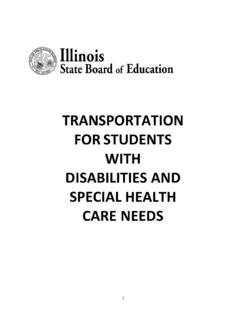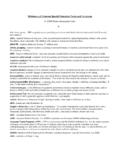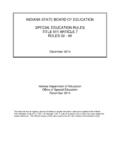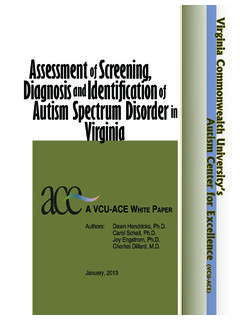Transcription of IEP MANUAL AND FORMS - Connecticut
1 Connecticut STATE DEPARTMENT OF education Division of Teaching and Learning Programs and Services Bureau of Special education IEP MANUAL AND FORMS January 2006 Revised December 2006 IEP MANUAL and FormsState of Connecticut IEP FORMS Effective January 2006 Revised December 2006 Introduction The United States Department of education , Office of Special education Programs (OSEP), has advised states that all IEPs written on or after July 1, 2005, must comply with the requirements of the 2004 Reauthorization of the Individuals with Disabilities education Improvement Act (IDEA). The position of the Connecticut State Department of education , Bureau of Special education , is that the January 2006 revised IEP FORMS serve a number of purposes. Its first purpose is to help insure compliance with the statutory requirements of IDEA and State Law. In addition, these FORMS assist as a data collection and student educational program-planning tool.
2 Therefore, the State Department of education has directed that all IEPs written for students in the State of Connecticut be completed on these FORMS . The following commentary (January 2006, Revised December 2006) is provided to school districts in Connecticut to assist them in utilizing the revised IEP FORMS . Please note, not every field in the IEP has a corresponding description. Written comments or questions regarding IEP FORMS may be sent to the Bureau of Special education , Box 2219, Room 369, Hartford, CT 06145-2219 (phone: (860) 713-6910) (E-mail: Please check our web site at for versions of the IEP and selected FORMS translated into Spanish. i January 2006 2006 1 1 PPT COVER PAGE The intent of this page is to indicate: demographic information about the student and parents; the purpose of the Planning and Placement Team (PPT) meeting; a list of the PPT members present; eligibility determination; and amendment to an IEP.)
3 Pages 1, 2 and 3, are designed to stand alone if the purpose of the PPT meeting is other than to develop or revise an IEP. These pages can serve as the record of the meeting and can be used to provide parents with Prior Written Notice of the outcome of the meeting. Conversely, if an IEP is being developed or revised, these pages can be attached to the IEP to provide all required information relative to the development of the document. If, by mutual consent of the parents and district, an IEP is being amended, pages 1, 2, 3 and supportive documentation will serve as a record of the agreed upon changes. General Information On this page, and on all subsequent pages, the date of the meeting at which the information for the form was generated should be entered in the space provided in the top right hand corner of the page, and the student s name, date of birth and school district in the space provided in the header of each page. If this is an amendment to an IEP, see Amendment to an IEP page 3 of this MANUAL .
4 Meeting Date Current Enrolled School is the school of attendance, where services are being provided to the student. It is the school where the student sits and is educated. Current Enrolled School Home School is the school in the district the student would attend if not disabled. Additionally, if the student attends a School of Choice, the School of Choice is their home school. ( , Charter and Magnet Schools, etc.) If the currently enrolled school and the home school differ check no and specify the name of the home school. If the currently enrolled school is the home school, check yes. Home School If the projected school for next year will be the home school, check yes. If the projected school next year is not going to be the home school check no and specify the name of the home school. School Next Year Districts should use the State Assigned Student Identification Number (SASID). If the District has an internal district ID number they may list both.
5 Eventually all data at the state level will be submitted and retrieved using the SASID number. Student ID # When completing the Race/Ethnicity and the Home Dominant Language fields, the response entered should be based on information obtained from the parent or student, not on one s personal judgment. Most typically, this information is collected when a student is first enrolled and parents complete racial/ethnic group and language survey FORMS , or when a student is evaluated to determine his/her dominant language. Currently, federal regulations allow for the assignment of one race/ethnic code. If the student or parent does not identify a racial or ethnic group, the district must select the most appropriate code. Race/Ethnicity, Home Dominant Language January 2006 2006 2 If the school district is one of the following, complete this prompt; otherwise please check NA. Bozrah Brooklyn Canterbury Columbia Eastford Franklin Hartland Lisbon Norwich Oxford Pomfret Preston Salem Sherman Sprague Sterling Voluntown Winchester School District without a High School Woodstock Student Instructional Language is an instructional decision of the school based on district criteria.
6 In SEDAC, this item is called English Proficiency and is addressed by yes or no. Student Instructional Language Provision has been made for the student s address. It is intended that the address of the student s primary residence, , where s/he spends most of her/his time, be entered on the Student Address1 line and the name of the parent/guardian with whom the child lives for the majority of the time be entered on the Parent/Guardian line below. This convention was adopted to help district staff identify where the student is to be transported if special transportation is required. If the student is in an out-of-home placement, enter the address of the parent whose address generates your district s jurisdiction (nexus) on this Parent/Guardian Address line. It is recognized that there are various FORMS of living arrangements and guardianships for students. Districts should feel free to fill in these fields with the most appropriate information for their use.
7 Additionally, spaces have been provided for phone numbers and districts should, likewise, use them for their convenience. Parent/ Guardian Address In the Most Recent Evaluation Date and Next Reevaluation Date fields, respectively, record the date of the most recent evaluation which served to determine eligibility for special education services and the date that the next reevaluation is due. As used here, the Most Recent Evaluation Date and Next Reevaluation Date fields do not refer to the date that a student was tested but rather, to the date that a PPT reviewed evaluation results and made a decision regarding eligibility for special education services. For example, if a child has recently been identified as eligible for special education services for the first time, her/his initial evaluation date would be the date of the PPT meeting that reviewed the results of an initial evaluation and determined that the student was eligible for special education services.
8 For this student, the next reevaluation date would be no more than three years from the exact date of this PPT meeting. This next reevaluation date would be the latest date that a PPT could meet to review the results of a reevaluation, consider the appropriateness of the student s program, and determine continuing eligibility for special education services. Most Recent Evaluation Date Under Reason for Meeting2 indicate the purpose of the meeting by checking the appropriate response. Recognize that it is possible for a PPT meeting to be convened for several different reasons so make certain to check all responses that apply. The reasons checked should match the Purpose of Meeting on the Parent Notice of PPT Meeting. Reason for Meeting Although it is possible that a student may have more than one disability, enter the disability which is most indicative of the student s primary disability. Disabilities eligible for special education services under IDEA or Connecticut statutes are as listed below.
9 (01) Intellectual Disability (ID) (06) Orthopedic Impairment (10) Multiple Disabilities (02) Hearing Impairment (07) Other Health Impairment (11) Autism (03) Speech Or Language (7A) ADD/ADHD Impairment (Sub-Category of OHI) (12) Traumatic Brain Injury (04) Visual Impairment` (08) Specific Learning Disability (15) Developmental Delay (Ages 3 to 5 only) (05) Emotional Disturbance (09) Deaf-Blindness TBD-no code Primary Disability January 2006 2006 3 Other Health Impairment (OHI) means having limited strength, vitality or alertness, including a heightened alertness to environmental stimuli, that results in limited alertness with respect to the educational environment, that (i) is due to chronic or acute health problems such as asthma, attention deficit disorder or attention deficit hyperactivity disorder, diabetes, epilepsy, a heart condition, hemophilia, lead poisoning, leukemia, nephritis, rheumatic fever, and sickle cell anemia: and (ii) adversely affects a child s educational performance.
10 Other Health Impaired The federal definition for OHI can be found 34 Section (c)(9). ADD/ADHD (Attention Deficit Disorder/Attention Deficit Hyperactive Disorder) is a sub-category of OHI and has been added so that the Department can distinguish OHI students with ADD/ADHD from students with other health related problems that are reported in this disability category. For a child to be identified as ADD/ADHD, the child must first meet the overall eligibility requirements for OHI and then, meet the more specific requirements for ADD/ADHD. ADD/ADHD It should be noted that the category of Multiple Disabilities is not simply that two or more disabling conditions are present but that the combination meets the conditions defined below. The federal law defines Multiple Disabilities as: ..concomitant impairments (such as mental retardation-blindness, mental retardation-orthopedic impairment, etc.), the combination of which causes such severe educational needs that they cannot be accommodated in special education programs solely for one of the impairments.

















